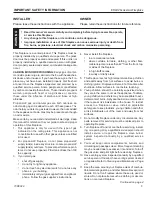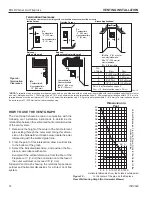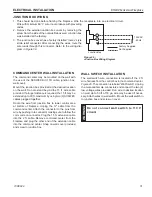
16
73D0024
KHLDV Series Gas Fireplace
VentInG InStaLLatIon
VertIcaL/HorIZontaL terMInatIon
conFIGuratIonS
Since it is very important that the venting system main-
tain its balance between the combustion air intake and
the flue gas exhaust, certain limitations as to vent con-
figurations apply and must be strictly adhered to.
The Vent Graph, showing the relationship between vertical
and horizontal side wall venting, will help to determine the
various dimensions allowable.
Figure 10
note: Horizontal sections of this vent system require
a minimum of 3" clearances to combustibles at the top
of the flue and 1" clearance at the sides and bottom
until the flue penetrates the outside wall. a minimum
1" clearance all around the flue is acceptable at this
point of penetration. unless the vertical run is 7
Z\x
feet
or higher from floor of fireplace, the clearance for the
horizontal run is 1" on all sides.
Vertical sections of this vent system require a minimum
of 1" clearance to combustibles on all sides of the
pipe.
When vent exits through foundations less than 20" below
outcrop, the termination must be flush up with outcropped
wall above.
It is best to locate the fireplace in such a way that minimizes
the number of offsets and horizontal vent length.
The horizontal vent run refers to the total length of vent
pipe from the flue collar of the fireplace (or the top of the
Transition Elbow) to the face of the finished outside wall.
•
The maximum number of 90° elbows per side wall
installation is three (3).
Figure 14
FP1176
max 90 bends
Figure 14 -
Maximum Three (3) 90° Elbows Per Installation
3 x 90°
Elbows
24" Min.
FP1176
Max 20"
Max 20"
36"
(914 mm)
Max.
36"
(914 mm)
Max.
FP1177
max horizontal run
FP1177
Figure 15 -
Maximum Horizontal Run with No Rise
A
B
10’
FP2133
Horizontal run
reduction
Figure 16 -
Horizontal Run
Reduction
FP2133
•
A minimum of 24" is required before a 90° elbow. If a 90°
elbow is fitted directly after 24" vertical section mounted
to the top of the fireplace, the maximum horizontal vent
run before the termination or a vertical rise is 36” (914
mm).
Figure 15
•
If a 90° elbow is used in the horizontal vent run (level
height maintained) the horizontal vent length is reduced
by 36".
Figure 16.
This does not apply if the 90° elbows
are used to increase or redirect a vertical rise.
example:
According to the vent graph (Page 14) the maxi-
mum horizontal vent length in a system with a 10' vertical
rise is 17
Z\x
’ (5.3 m) and if a 90° elbow is required in the
horizontal vent it must be reduced to 14
Z\x
' (4.4 m).
In
Figures 16 and 17
dimension A plus B must not be
greater than 14
Z\x
' (4.4 m).
90° Elbow = 36" (914 mm)
Reduction






























